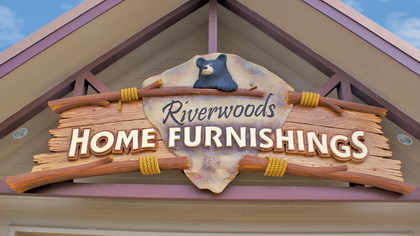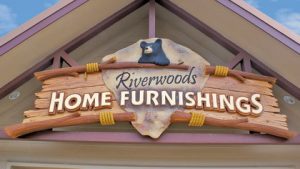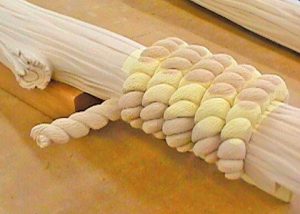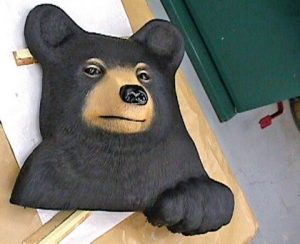Jodi and Steven Spangler, a high-energy and multi-talented young couple, have operated fine-art, real-estate and furniture enterprises locally for more than a decade. They hired us to design a logo and a dimensional sign to amplify the entrance gable of their forthcoming, upscale, home-furnishings store. Influenced by the rustic theme, and the horizontal orientation of the gable, I began developing a plan.
Design
Our work is often defined by the use of genuine materials because, although less-expensive, imitation products have improved, they still don’t match the natural textures and rich appearance of real stone, wood, rope and other organic choices. However, this project, which implements an almost cartoonish design flair, required such handcrafted elements as background planks, logs and ropes to achieve appropriately exaggerated proportions. Considering these complex elements, we knew 15-lb. Sign•Foam® HDU and Dow Chemical insulation foam would be light enough to allow safe installation on the building’s gable truss.
We’ve been evolving our CAS “presentation art” while attempting to avoid the sterility that usually accompanies the process by scanning hand-rendered sketches into Photoshop or Corel and cleaning up details electronically. The client approved the concept design, and we moved into tackling complex fabrication and safe installation while finishing under budget.
Engineering success
Advertisement
“Dimensional engineering” is my term for composing the parts and determining the thickness, shape and interrelation of all design elements. We’ve all seen cut-out letters too thick for their relative height – a telltale sign of poor dimensional engineering. This project’s many elements required careful consideration of appropriate scale, as well as attachment details.
I calculated the sign and all its components would weigh approximately 550 lbs. After having consulted with the architect about the gable’s weight-bearing capacity, he approved my steel-tube armature design, which effectively distributes the load and rests nicely on the truss. Keith Miller, proprietor of Sevierville’s Miller Ironworks, expertly handled its fabrication.
The gable’s truss comprises three, stack-laminated 2 x 6 lumber trusses wrapped in cement board. We couldn’t sacrifice its structural integrity by drilling mounting holes into our armature, which is designed to sit on, and clamp to, the truss assembly.
Fabrication and finishing
For some time, we’ve developed what I call “artifact carving” techniques. Our area is rich in stone-toolmaking history; therefore, the use of chipped-stone artifacts in our signs expresses local pride. For this project’s stone artifact, we laminated pieces of 15-lb. Sign•Foam, up to 6 in. thick, with Gorilla Glue, while forming an offset on the back to key-mount onto the armature.
Advertisement
Then, we created the chip contours by slap-carving, which is a quick, effective technique for creating a convincing, random-looking chipped effect with softer substrates. I achieve this with an aggressive, controlled motion using a rotary grinder or cutter. Only an experienced craftsman should attempt this. We fashioned a lap joint on both back sides to allow materials’ expansion and contraction.
The “Riverwoods” letters were round-bottomed and incise-carved, and we chip-carved around all the raised elements for a transitional texture. To make the faux-stone finish, we used acrylic paints that we topcoated with matte- and semi-gloss Matthews acrylic-polyurethane clearcoat.
To fashion the bear cub, we laminated a 10-in.-thick slabs of 15-lb. Sign•Foam before Michael Dudley, our apprentice fabricator, “exposed” the bear using grinders, chisels and abrasives. We pin-mounted it to the artifact with a paw hanging over a branch.
We sculpted the wood-grain plank panels from lightweight insulation foam with Demand Products’ hot-iron tools. Then, we coated this layer with Volatile Free Inc. 4-lb., rigid foam insulation before ClemCo’s (Sevierville) Lew Stamm demonstrated his wood-graining technique.
The “branch logs” overlap the plank panels and extend over the artifact, so the mounting and assembly order is critical. We glued numerous Sign•Foam strips and laminated portions of the branches up to 12 in. thick before shaping. Michael then sculpted branch shapes with a 4-in.-long, carbide disc grinder. Then, Anna and I scratched out the final bark texture with V-chisels and various grits of sheet abrasives. I crafted the broken branch ends and collars with deep gouge hogging, a Foredom rotary grinder and wire-brush rasps. Raphael Casco created the rope’s final texture with a carving knife and wire brushes. We finished the branches and ropes with a semi-transparent stain to emphasize the coarse texture.
Advertisement
“Home Furnishings” required a sawed and edge-chamfered, 1-in.-thick Sign•Foam top layer over an oversized, 2-in.-thick, insulation-foam cutout with a heat-treated, scalloped-edge.
The finishing touches
Field installation required careful sequencing, which we began after having carefully packed and transported all the sign elements to the jobsite 40 minutes away. There, a forklift waited to hoist the armature into its final position. We attached it securely to the gable truss before we hooked the central artifact prior to the remaining graphic elements – we used very few mechanical fasteners, and none are visible. The installation proceeded flawlessly thanks to careful planning, a good crew and valuable assistance from Andy Woodson, a seasoned local installer.
I can’t express too strongly my appreciation for an open-minded client; Vicki, my wife and inspiration; and Anna and Michael, who stepped up and exceeded the call of duty. They’ve affirmed my confidence in our apprenticeship program and offer a stark contrast to today’s prevalent lack of commitment and work ethic. An apprentice who covets his/her craft above the dollar will ultimately excel in both.
Equipment and Materials
Adhesive: Gorilla Glue, available from local hardware or home-improvement stores, or Gorilla Glue Inc. (Cincinnati), (800) 966-3458 or www.gorillaglue.com.
Coatings: Acrylic-polyurethane paint, from Matthews Paint (Pleasant Prairie, WI), (800) 323-6593 or www.matthewspaint.com; encapsulant spray finish, from Volatile Free Inc. (Brookfield, WI), (800) 307-9218 or www.volatilefree.com.
Software: Photoshop®, from Adobe Corp. (San Jose, CA), (408) 536-6000 or www.adobe.com; CorelDRAW®, from Corel Corp. (Ottawa, ON, Canada), (800) 772-6735 or www.corel.com.
Substrates: Sign•Foam 15-lb. HDU, from Sign Arts Products Corp. (San Juan Capistrano, CA), (800) 338-4030 or www.signfoam.com; Dow insulation foam, available from building-supply companies and hardware stores, or Dow Chemical Co. (Midland, MI), (989) 636-1000 or www.dowfoam.com.
Tools: Foam-fabrication tools, from Demand Foam Cutting Systems (Alpharetta, GA), (800) 325-7540 or www.demandfoamcutting.com; handcarving tools, from Ashley Iles Edge Tools Ltd. (Spillsby, Lincolnshire, England), www.ashleyiles.co.uk, or Rockler Woodworking and Hardware (Medina, MN), (800) 279-4441 or www.rockler.com.



 Tip Sheet1 week ago
Tip Sheet1 week ago
 Ask Signs of the Times2 days ago
Ask Signs of the Times2 days ago
 Real Deal1 week ago
Real Deal1 week ago
 Benchmarks5 days ago
Benchmarks5 days ago
 Editor's Note2 weeks ago
Editor's Note2 weeks ago
 Women in Signs1 week ago
Women in Signs1 week ago
 Product Buying + Technology2 weeks ago
Product Buying + Technology2 weeks ago
 Photo Gallery6 days ago
Photo Gallery6 days ago













